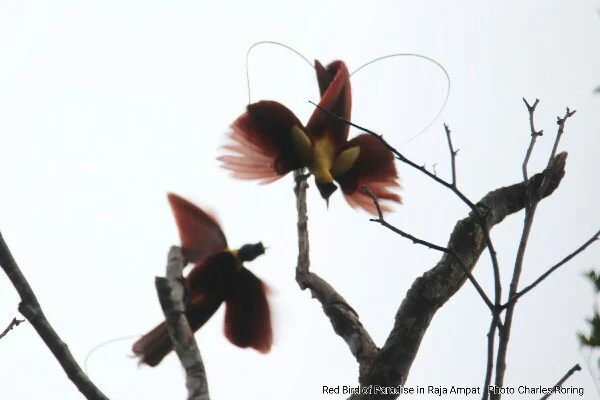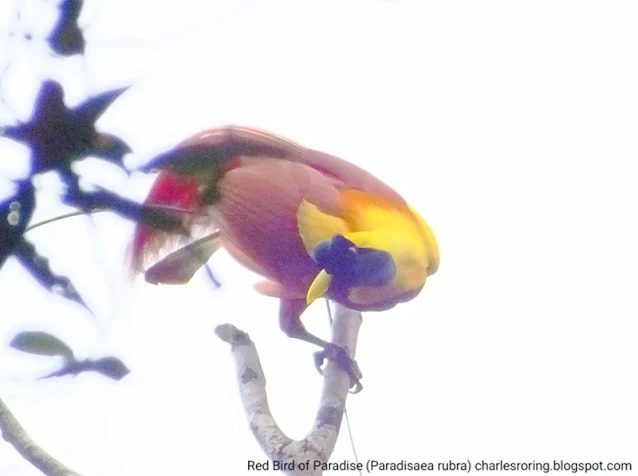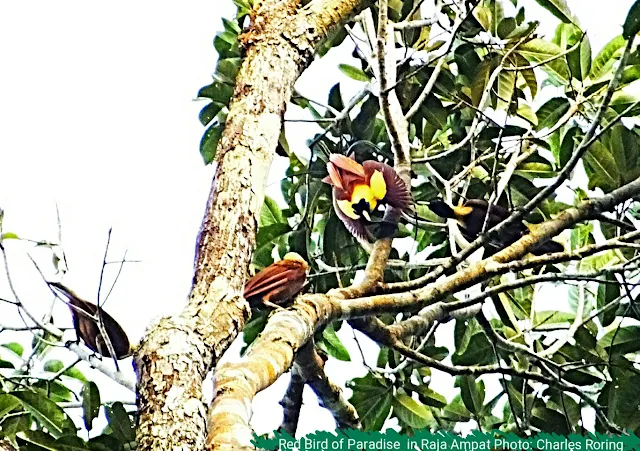Birdwatchers who travel to Raja Ampat will usually put the Red Bird of Paradise (Paradisaea rubra) in their list of target birds to see. The best times to watch this bird are in the mornings and in the afternoons. There are a lot of places which visitors can choose if they want to watch the paradise bird in Waigeo island. Most tourists go to Saporkren area. I go to different places. Some are located in eastern area of Waigeo whereas others are located further in the south and in the north of the island. There, I and my guests can enjoy exclusive sites for watching the paradise birds and other tropical birds of Raja Ampat. My recommendation will be the southern hill of the island. There are also other forests in north-east region of Waigeo which tourists can go to enjoy birding.
 |
| Male Red Birds of Paradise were performing their courtship dance |
 |
| Red Bird of Paradise (Paradisaea rubra) |
I highly suggest that visitors bring a good pair of binoculars, and a camera with telephoto lens if they want to take pictures of this beautiful creature. Usually, at least 2 to 4 male birds gather on top of a tree located deep on a hill of the forest. They start calling their female counterparts for mating. When the female Red Birds of Paradise have come, the male ones will perform their courtship dances. They compete one another to win the female birds. Most often the competition gets tougher. The one that is stronger and performs better dance will become the winner. This is a natural selection.
 |
| Red Bird of Paradise in northeast forest of Waigeo |
Tropical Birds in Raja Ampat
There are a lot of other birds that we also can see while traveling in Waigeo and other smaller islands around it. They include Wilson's Bird of Paradise, Hooded Butcherbird, Palm Cockatoo, Great-billed Parrot, Sulphur-crested Cockatoo, Eclectus Parrot, Pinon Imperial Pigeon, Pied Imperial Pigeon, Spice Imperial Pigeon, Brown Cuckoo Dove, Great Cuckoo Dove, Beach Kingfisher, Rufous-bellied Kookaburra, Common Paradise Kingfisher, Yellow-faced Myna, Moustached Treeswift, Wimbrel, Beach Thick Knee, Radjah Shelduck, White-breasted Woodswallow, Sahul Sunbird, Singing Starling, Lowland Peltop, Eastern Osprey, White-bellied Sea Eagle, and a lot more.
When I guide tourists to these small islands, I charter a small motorized boat. I also bring a spotting scope which I like to install at a beach to watch coastal birds such as Willie Wagtail, Eastern Reef Egret, Brahminy Kite, White-bellied Sea Eagle, Little-pied Cormorant, and Sahul Sunbird.
Most birdwatchers bring binoculars but there are also tour participants who bring birding cameras. The development of digital camera with telephoto lens such as Nikon P900, or Nikon Coolpix P1000 has increased the chance of birdwatchers to shoot birds in distant and very tall trees. I used Fujifilm HS50EXR to shoot the birds above. Now a lot of pictures of beautiful birds are circulating in social media. They are made using the superzoom photographic devices. Digiscoping system can also produce good quality pictures of birds but they are mostly used by birdwatchers in open areas such as a field with trees around it or clearing areas near a forest. For taking pictures of birds in thick forest, a camera with telephoto lens is more convenient.
However, most birdwatchers will be happy to watch birds using spotting scope too because they can see the vivid colours of their feather through the scope. Famous brands like Swarovski, Leica, and Nikon are very good but expensive. I use Kinglux 20-60×60. Although it is considered as entry level scope, it is quite good. It has got Bak 4 prism in its barrel.
There are a lot of other birds that we also can see while traveling in Waigeo and other smaller islands around it. They include Wilson's Bird of Paradise, Hooded Butcherbird, Palm Cockatoo, Great-billed Parrot, Sulphur-crested Cockatoo, Eclectus Parrot, Pinon Imperial Pigeon, Pied Imperial Pigeon, Spice Imperial Pigeon, Brown Cuckoo Dove, Great Cuckoo Dove, Beach Kingfisher, Rufous-bellied Kookaburra, Common Paradise Kingfisher, Yellow-faced Myna, Moustached Treeswift, Wimbrel, Beach Thick Knee, Radjah Shelduck, White-breasted Woodswallow, Sahul Sunbird, Singing Starling, Lowland Peltop, Eastern Osprey, White-bellied Sea Eagle, and a lot more.
When I guide tourists to these small islands, I charter a small motorized boat. I also bring a spotting scope which I like to install at a beach to watch coastal birds such as Willie Wagtail, Eastern Reef Egret, Brahminy Kite, White-bellied Sea Eagle, Little-pied Cormorant, and Sahul Sunbird.
Most birdwatchers bring binoculars but there are also tour participants who bring birding cameras. The development of digital camera with telephoto lens such as Nikon P900, or Nikon Coolpix P1000 has increased the chance of birdwatchers to shoot birds in distant and very tall trees. I used Fujifilm HS50EXR to shoot the birds above. Now a lot of pictures of beautiful birds are circulating in social media. They are made using the superzoom photographic devices. Digiscoping system can also produce good quality pictures of birds but they are mostly used by birdwatchers in open areas such as a field with trees around it or clearing areas near a forest. For taking pictures of birds in thick forest, a camera with telephoto lens is more convenient.
However, most birdwatchers will be happy to watch birds using spotting scope too because they can see the vivid colours of their feather through the scope. Famous brands like Swarovski, Leica, and Nikon are very good but expensive. I use Kinglux 20-60×60. Although it is considered as entry level scope, it is quite good. It has got Bak 4 prism in its barrel.
I often combine the birding tour in Raja Ampat with snorkeling tour and with rainforest tour in Sorong regency or Manokwari.
Also read:
Raja Ampat Birds
Raja Ampat Birds

No comments:
Post a Comment